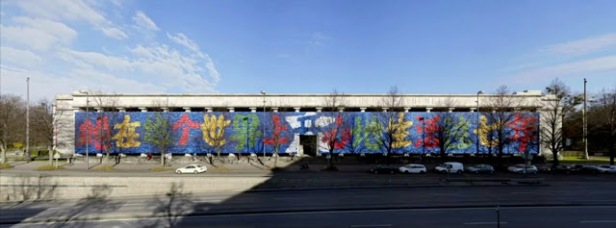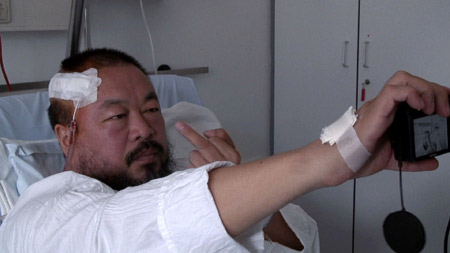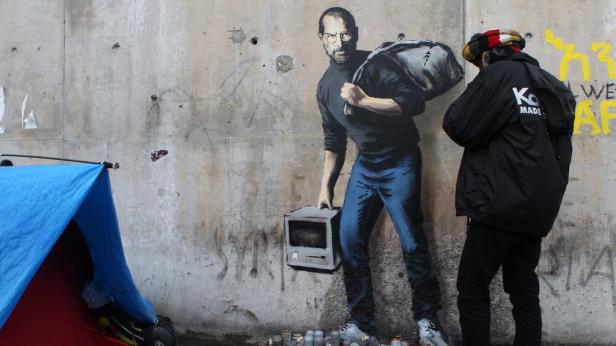“After a year of knocking on doors, we had the names of 5,129 children who had died.”
Caused by the Sichuan Earthquake in 2008, these deaths were not reported to the public by the Chinese government. At the time, the government was controlling and censoring the information regarding the earthquake and even detaining activists and victims’ relatives; Ai Weiwei decided to speak up. He wrote angry blog posts criticising the corrupt government. He also filmed a documentary called So Sorry which investigated the number of deaths in the earthquake due to poor government initiative for proper construction of buildings.
After a year of seeking hidden information from the government, in 2009, Weiwei put up 9,000 backpacks on the facade of a building in Munich, Germany, to commemorate the school children who had died. This art piece was named Remembering as part of his art show called “So Sorry.” The colorful backpacks spelled out a sentence in Chinese that translates to “She lived happily for seven years in this world.” A quote from a mother of one of the victims.

As expected, Weiwei was threatened by the police at his home and was left with a cerebral hemorrhage due to police brutality in his hotel room a few months later. Coincidentally, he was attending the trial of an earthquake activist at the time.

After ArtReview named him the Most Powerful Artist in the World in 2011, Weiwei was arrested by the Chinese government and held for 81 days under tight supervision. According to the government, Weiwei had high taxes and fines due; however, his punishment implied otherwise.
Weiwei’s passport was confiscated and he was not allowed to travel abroad. All the computers and hardware from his house were also carried away by the government. After he returned, he did not give any information about his arrest and refused to speak up against the government for a while.
Some might argue that the Chinese government is not at fault since freedom of media and art should be limited because it can influence wrong ideas.
For example, the Islamic State of Iraq and Syria (ISIS) uses social media like Twitter to influence and recruit people all over the world. They create many accounts online to persuade people and often upload videos of executions to incite fear. In fact, they are known to be the terrorist group who is the most proficient in using social media to influence their target audience. According to a study done by Stanford, in 2015 alone, 17 million tweets related to ISIS spread ideas of violence and oppression which influenced people around the world. Some might argue that the one of the main reasons they are so powerful in spreading wrong ideas is because of the freedom of media.
Some might also argue that the freedom of art and media should be limited because of how sensitive topics can be misinterpreted and lead to huge controversies.
Vincent Valdez, a Mexican American artist, painted a group of klansmen set in a modern-day background called The City. His intention behind the painting was to recognize the fact that racism and white supremacy is still prevailing today and people are failing to acknowledge it.
However, it was misinterpreted and led to controversy since racism suffered by the African American people at the time was historically more violent and severe than it was for the Mexicans. According to the critics of this piece, the artist was being very culturally insensitive. Some also stated that glamorization and profit from a theme so harrowingly central to the African American identity using the excuse of freedom of art is not acceptable.

Similar to Valdez, Dana Schutz, a female American artist, painted the mutilated photo of Emmett Till inside his coffin in 2016 called Open Casket.

The 14-year-old boy had been lynched by two white men after being accused of allegedly whistling at and grabbing a white woman’s waist, which was illegal at the time of the Jim Crow laws. After his death, the woman confessed that her testimony was false.
Schutz painted the piece because, being a mother, she wanted to convey the grief a mother feels when she loses a child. Racial segregation was not a part of the message. The painting was not for sale either, so gaining profit was not her intention.
The fact that the artist is a white woman painting about a historically central theme related to the black community angered a lot of people. Similar to The City, Open Casket received criticism for being culturally insensitive. People called Schutz ignorant and accused her of using art as an excuse to glamorize such an event.
For both paintings, The City and Open Casket, glamorization was not their intention. The main reason art causes misinterpretations is due to the lack of knowledge about the context of why the artist chose the paint it.
I believe freedom of art and media spreads awareness and is a tool to influence change.
Chris Jordan, an American digital photographer, has a series of pictures named “Running The Numbers II.” A corporate lawyer turned photographer, he creates different, large scale images using thousands of pieces of plastic. From afar, they look like paintings; however, after taking a closer look, little pieces of plastic are noticeable to the eye.

Jordan is trying to spread awareness about the impact of mass human consumption and how it impacts the climate. In this specific photograph, Whale, he shows the amount of plastic floating in every square mile of the ocean: 50,000 plastic bags. He is spreading awareness about how plastic impacts marine life and wants people to minimize the amount of plastic they waste.
The world-renowned street artist Banksy creates art which is satirical and conveys political and social messages. Some of Banksy’s artwork relates to the issue of immigrants in Europe. The son of a migrant from Syria is painted on the wall of the “Jungle” migrant camp in Calais, a French town. It shows Steve Jobs, whose biological father was a Syrian refugee, carrying a trash bag in one hand and the first model of the Mac computer in the other hand.

Banksy’s argument is how European nations are saying that immigrants are draining their nations of resources; however, the reason Apple, one of the world’s most profitable companies, exists is because of a Syrian migrant. Banksy is spreading awareness about how selfish European nations are not accepting migrants. He is also influencing people to change their stereotypes and opinions about immigrants.
Similar to Banksy, at the 21st Biennale of Sydney, Weiwei presented a piece called Law of the Journey, which shows a huge 60-feet-long lifeboat holding 300 anonymous passengers made out of black material. The black material was made in a Chinese factory which produces the lifeboats refugees use to escape.
His argument is that people are ignoring the huge scale at which human beings are being displaced from their homes. Accompanying this piece, Weiwei recently released another original documentary called “Human Flow” in which he documents the struggles of the displaced people through their experiences. According to Weiwei, “There’s no refugee crisis, only a human crisis … In dealing with refugees we’ve lost our very basic values. In this time of uncertainty, we need more tolerance, compassion and trust for each other, since we are all one, otherwise humanity will face an even bigger crisis.” He is spreading awareness about the ongoing refugee crisis and is striving for change by advocating for the human rights for the refugees through his art.

Freedom of art and media sometimes influences wrong ideas and can be misinterpreted which can often lead to conflict; however, it also spreads awareness about important issues and advocates for change. Other than freedom of speech, the world needs an outlet for people’s voices. The freedom of art and media give people the platform to send a powerful message.
A week ago, Woodstock hosted its first Documentary Film Festival. Showing films regarding various controversial issues, this event gave people an opportunity to learn new things and a motivation to contemplate ideas. One of the films, Never Sorry, about Ai Weiwei’s life as an artist specifically stood out to some people because of how inspiring it was. According to Mr. Ed Beavan, a history teacher, Weiwei can even be considered a “hero.”
People found Weiwei inspiring because of the way he conveys his ideas and how unfazed he is by the Chinese government, even if it means putting his life at stake. Weiwei’s work creates an impact on people by motivating them to take action against any injustice and speak out their opinions. It inspires the young people of our generation to take initiative to strive for change.
Art and media are modes of communication which free us from geological borders, the boundaries of culture, language, and the government. To move forward, the world needs inspiring people like Ai Weiwei. To move forward, the world needs freedom.
At Woodstock, this freedom is limited by the school authorities. In fact, if I were to write something too “problematic” in this opinion piece about the freedom of art and media, I would probably not be allowed to publish it.


Nice one, chugangggg
LikeLike
Thanks for your support!
#chugang
LikeLiked by 1 person
Wow this is such a greatly written article on a daily conflict we face every day. Freedom of speech and to what extent it should be used. I think it is up to us to utilise it as something positive, but I guess that’s not how world works… your article has made me think deeply about it again. Thanks for that! Expect to see more great pieces from you!
LikeLiked by 1 person
Thank you so much!
LikeLike
Well done! I also agree to the statement where you mentioned amongst today’s youth, people need an outlet express their ideas and opinions which is not necessarily known as’ freedom of speech’.
LikeLiked by 1 person